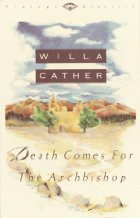
In James Wilson's prologue to his excellent history of Native America, The Earth Shall Weep, he discusses the idea of the "Vanishing American," still disturbingly prevalent in white American culture. This myth consists of
the central belief that 'the Indian' belongs essentially to the past rather than to the present. He (or she) is an exotic relic of some earlier age that we have already passed through: either - depending on your point of view - a kind of primitive anarchy that we have overcome (in nature, in ourselves) or an innocent Golden Age that we have forfeited through greed and destructiveness....Its key argument is that, because native and non-native inhabit essentially different realities, they cannot be expected to co-exist: by definition, yesterday must always give way to tomorrow....While they testify to our [white folks'] ability to develop and progress, Native American societies are incapable of change themselves...they cannot adapt when confronted by a more advanced and virile civilization, but are doomed to melt away...If they fail to vanish, if they change and adapt instead, then, by definition, they are not really Native Americans.
I thought about this idea frequently while perusing Willa Cather's 1927 novel Death Comes for the Archbishop. For most of the book, I considered it an excellent example of Wilson's point. Here Cather presents us with a white French bishop, sent as a missionary to the newly-Americanized Santa Fé diocese, who, when confronted with the Native mesa-dwelling Ácoma people, perceives them as some kind of petrified relic of the past:
Through all the centuries that his own part of the world had been changing like the sky at daybreak, this people had been fixed, increasing neither in numbers nor desires, rock-turtles on their rock. Something reptilian he felt here, something that had endured by immobility, a kind of life out or reach, like the crustaceans in their armour.
For Father Latour, the Ácoma seem so "antediluvian" and unchanging that he finds it difficult even to see them as human. He interprets their lack of receptivity to his mass as evidence of their own sequestration and prehistoric level of development, rather than as a result of his own decision to insert himself uninvited into their lives:
He felt as if he were celebrating Mass at the bottom of the sea, for antediluvian creatures; for types of life so old, so hardened, so shut within their shells, that the sacrifice on Calvary could hardly reach back so far. Those shell-like backs behind him might be saved by baptism and divine grace, as undeveloped infants are, but hardly through any experience of their own, he thought. When he blessed them and sent them away, it was with a sense of inadequacy and spiritual defeat.
Of course, the perceptions of a character shouldn't be confused with those of his author, but Cather seems, in this scene, to be in sympathy with Latour. Certainly, all her stories and descriptions of the Ácoma way of life imply an ancient, unchanging aspect similar to the priest's assessment (if slightly less dehumanizing). Not only that, but other Native settlements are also described as declining; the Bishop's Indian guide Jacinto lives in a house
at one end of the living pueblo; behind it were long rock ridges of dead pueblo,--empty houses ruined by weather and now scarcely more than piles of earth and stone. The population of the living streets was less than one hundred adults. This was all that was left of the rich and populous Cicuyè of Coronado's expedition.
To a certain extent, this is simply accurate reporting on the devastation brought to Native communities by European diseases. But it's more than that: the melancholy mood, combined with Jacinto's refusal to let Father Latour assist his ailing infant, paint the same picture of the unchanging, unchangeable Indian, destined to melt away under the onslaught of White Progress. Jacinto is portrayed as in touch with "ancient" powers invisible to Latour (or at least, Latour imagines him to be), but he is also a member of an America in the midst of an inevitable vanishing.
This echoed, for me, the portion of Cather's earlier novel The Professor's House set in the southwest, in which two white men come across the ruins of an ancient Native cliff-dwelling civilization, now extinct for many years. The discovery is a revelation to the fledgling archaeology students, and one in particular, Tom, forges a deep spiritual connection with the place. Tom makes the long journey to Washington, attempting to interest the Smithsonian in the site's artifacts, while in the meantime his friend betrays him by selling everything to a souvenir-hawker. The reader is sympathetic with Tom's desire to preserve the marvel he has found, but at the same time the actual Native presence in the place - the significance the site held to its original inhabitants and makers - is eclipsed by a set of meanings created by the white discoverers. Even the most positive possible outcome - that the site would be purchased and curated by an institution like the Smithsonian - is constructed entirely from white value systems and white institutions. The Native voice has long been silenced, a relic of ancient history. And although the Indians of Death Comes for the Archbishop are technically still alive, much in their portrayals implies that they are rapidly heading the same way.
And then, with only a few pages remaning, Cather surprised me. Latour, now lying on his death-bed, recalls his friend Eusabio, a Navajo leader who had asked him, many years before, to intercede with the United States government during the events later known as the Long Walk of the 1860's, when the Navajo were being forcibly relocated away from their sacred lands. Although he refuses the request (he doesn't believe his intercession would hold any weight with the Protestant legislators), he is sympathetic to the Navajo battle, and rejoices when the government reverses its decision and allows the people to return to their ancestral home. The Navajo, in this part of the book, are portrayed as much more active makers of their own destinies than either the Ácoma or the Cicuyè; forced into hiding in the canyons and crevices of their native lands, the few remaining freedom fighters must drastically alter their mode of life in order to elude the US troops. Not only that, but they are making their decisions in full possession of the facts, and of their faculties; the resistance leader Manuelito tells the Bishop:
"You are the friend of Christóbal, who hunts my people and drives them over the mountains to the Bosque Redondo. Tell your friend that he can come and kill me when he pleases...my mother and my gods are in the West, and I will never cross the Rio Grande."
This kind of free decision-making and articulate defiance, while still tinged with the notion of the Noble Savage holding out hopelessly against Progress, is leagues away from Cather's depictions of the doomed Ácoma or the extinct cliffside civilization in The Professor's House. Manuelito and Eusabio are admirable humans who make their own decisions, and are capable of change. Significantly, Manuelito's story ends, not with his death at the hands of the US cavalry, but with the return of his people to the land he has defended. And, equally significantly, the very last words out of the dying Latour's mouth are these: "I do not believe, as I once did, that the Indian will perish. I believe that God will preserve him."
Death Comes for the Archbishop definitely reflects the casual racism of its time; I haven't even touched on the depictions of Mexicans in the novel. But I also think it reflects an interesting moment in American history, when white culture was beginning, perhaps, to fumble towards a recognition of the shared complexity and humanity of Native Americans - toward an acknowledgment that these are living, dynamic people, not merely signposts on the road to the past.


I'd been putting off reading your review of this work until I'd finished my own, Emily, but I think you did a great job of higlighting
a lot of the novel's internal ethnic "tensions." From a modern-day perspective, I think these are some of the more interesting, if frustrating, aspects of what's an otherwise only occasionally engaging story. Please let me know if you mind me linking to your fine review!
Well, I'm coming into this exactly two years two late but...
I think Latour although viewing the Indians as ancient and harking back to a distant past, he didn't view them as "vanishing" but rather as eternal and embedding into and inseperable from their foundimental. Even from the very beginning of the book, Latour admired the Indians and their antiquity.
I interpretted the Mass passage somewhat differently than you did. I think Latour felt the inadequicy of the Mass was because of his own shortcomings in not recognizing how ill fitting such a modern unrooted sentiment would be to a populace rooted more deeply to their past then even the most ancient European Cathedrals.
He is told early on by Martinez that the Church would never take away and could never compete with the past. Latour, in turn, never actually wanted to and viewed the Indian ways and passions as complimentary and compatible and even exemplary of his Catholic views.
(In which, I imagine, he was completely unlike his historical inspiration Bishop Lamy. The only thing I actually know of Lamy is that when Bishop Martinez suspended tithing as the Indians lived in poverty and couldn't afford it, Lamy insisted upon tithes and withheld sacrements from those who wouldn't pay. Gee... Classy.)
Actually, I found the book a bit difficult at times because as a late 20th century reader I am rather cynical of both the church and the white man's historical heritage. Death comes to the Archbishop seems to be completely unconcerned with the implications and conflicts of these and utterly ignores the rather nasty business of *conversion* (which nearly always means competing with and abandoning and quelching one's native ways.) Instead the book treats European missionaries as a de facto accepted addition to the west. It's as though Latour and Vaillant were mere doctors or teachers dispensing an unquestioned good. As such, they are a quite palatable and sympathetic and even progressive. But to view Catholic missionaries in such a light required a leap of faith I'm not accustomed to making.